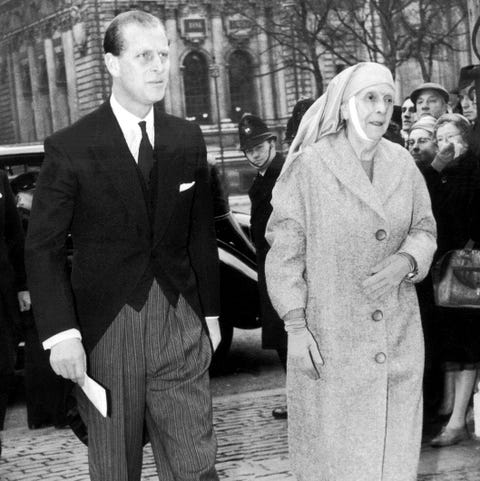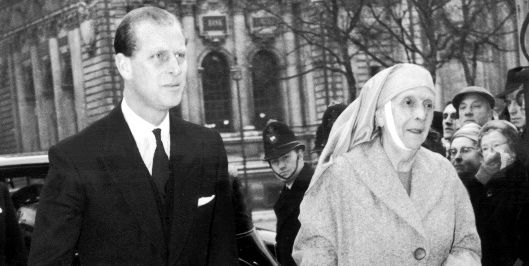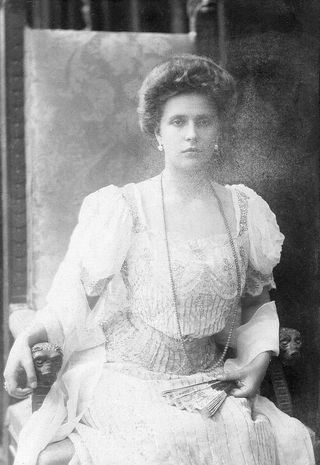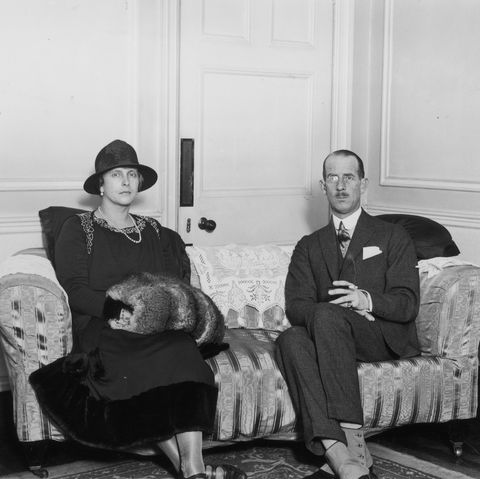
Keystone-FranceGetty Images
The Crown‘s fourth episode of season 3 opens in an unexpected location: 1967 Greece. We meet a fantastic older woman sporting a nun’s habit, toting a lit cigarette, and insisting (in Greek) that she’ll do whatever she can to keep her convent open. When the nun tries to sell a massive sapphire-and-diamond brooch to an Athens jeweler, he alerts the authorities, believing the item is stolen. Those authorities, in turn, discover the nun is actually Princess Alice of Battenberg, Prince Philip’s mother and Queen Elizabeth’s mother-in-law.
These scenes are surprising, though the police raid did not happen in real life, as The Crown historical advisor Robert Lacey writes in The Crown: The Official Companion Volume 2. The true story of Alice’s life, however, is more unbelievable than fiction. Let’s dig into it.
Born into royalty
Princess Alice was born at Windsor Castle in 1885, the daughter of Prince Louis of Battenberg and Princess Victoria of Hesse and by Rhine, and the great-granddaughter of Queen Victoria, who witnessed Alice’s birth. (Victoria is both Queen Elizabeth and Prince Philip’s great-great grandmother.) According to The Telegraph, Alice was diagnosed as congenitally deaf as a child and learned to communicate by lip-reading.
At only 17 years old, she fell “really, deeply in love” with Prince Andrew, the fourth son of the King of Greece, when they met at King Edward VII’s coronation in 1902. The young couple were married in a German ceremony just one year later. Their 1903 wedding announcement in the New York Times archives reveals they received at least $750,000 in wedding gifts—that’s almost $23 million in 2019.
The couple lived in Greece and welcomed five children in 12 years. Their youngest and only son was Prince Philip, Queen Elizabeth’s future husband. In fact, the diamonds in Elizabeth’s engagement ring came from a tiara gifted to Alice on her wedding day from Tsar Nicholas II and Tsarina Alexandra of Russia, according to Town and Country. Philip also used diamonds from the tiara to make a bracelet for Elizabeth as a wedding gift.
Royal refugees
The Greek royal family fled Greece in 1922 after the start of the second Greco-Turkish war. In episode 4 of The Crown season 3, Princess Anne teases her father about escaping Greece in a lemon crate. He corrects her, pointing out that it was for oranges—this anecdote remains a real-life legend to this day.
According to the British Psychological Society’s The Psychologist, the years following that escape were particularly hard on Princess Alice. She was diagnosed with schizophrenia at the end of the 1920s and soon institutionalized. Sigmund Freud took an interest in Alice’s case because she experienced fantasies that were religious and sexual in nature, and he recommended X-raying the young royal’s ovaries to bring on menopause, despite her protestations.
“It was rather hushed up,” Alice’s niece, Countess Mountbatten, revealed of Alice’s treatment in a 2012 documentary. “I think my aunt w0uld have suffered very much.” Lacey writes that Philip saw very little of his mother during his childhood.
A woman of charity
According to The Psychologist, Alice left treatment sometime in the mid-1930s and returned to Greece and a life of charity, volunteering with the Red Cross and soup kitchens, Lacey writes in The Crown: The Official Companion Volume 2. During World War II, the princess hid a family friend, Rachel Cohen, and her young daughter and son in the apartment where she was living. According to Yad Vashem, the World Holocaust Remembrance Center, when the Gestapo became suspicious and questioned Alice, she pretended she couldn’t hear them. Yad Vashem named Princess Alice Righteous Among the Nations in 1993, and Prince Philip traveled to Jerusalem for the tree-planting ceremony in Alice’s honor.
In 1949, Alice founded the Christian Sisterhood of Martha and Mary in 1949 and spent years attempting to secure funding for it, according to her New York Times obituary. She moved into Buckingham Palace in 1966 and spent the last two years of life there, growing particularly close to Princess Anne, according to Lacey. Princess Alice died on December 5, 1969.


